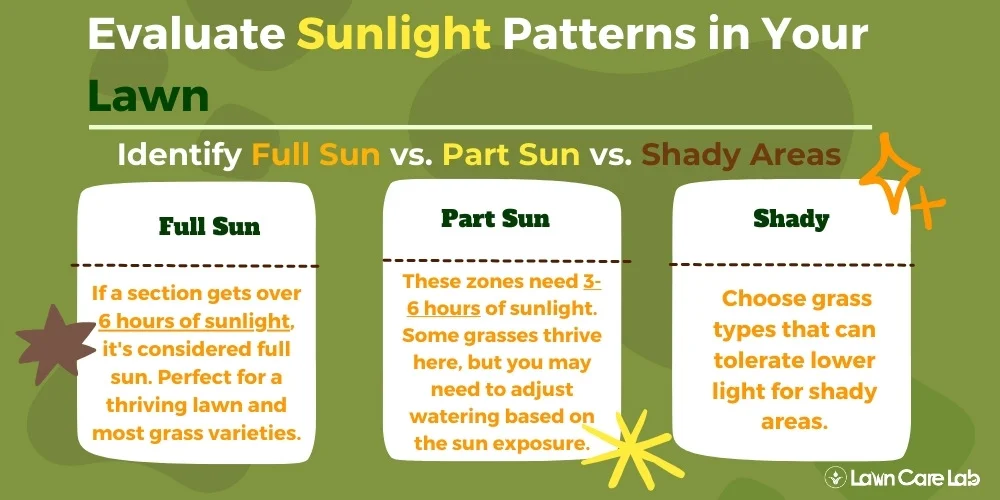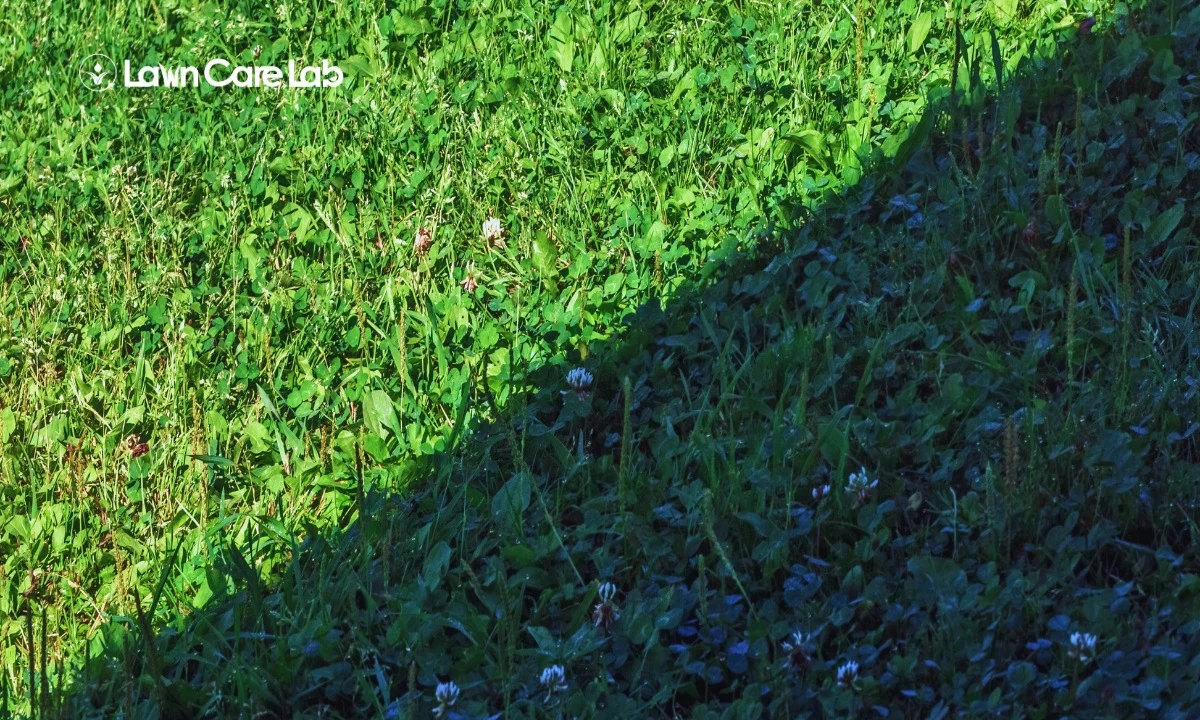Having your morning coffee and notice the problematic patches on your lawn? Not all areas of your yard get the same sunlight, and your grass clearly shows it.
Don’t worry, though! We’ll guide you on evaluating your lawn’s exposure to sunlight, picking the perfect grass for each area, and enhancing your lawn care.
We’re going to transform your lawn into a thriving, green oasis, optimizing Your Lawn for Sun or Shade.
Table of Contents
Evaluate Sunlight Patterns in Your Lawn

Before you pick out plants or grass for your yard, take a good look at the sunlight in different areas. Check out which spots get full sun, part sun, or are mostly shady. Different plants do well in specific light conditions.
Identify Full Sun vs. Part Sun vs. Shady Areas
Track your garden’s sun exposure to understand how much sunlight your lawn needs. This helps you zone your lawn effectively.
Look at these factors:
- Full Sun: If a section gets over 6 hours of sunlight, it’s considered full sun. Perfect for a thriving lawn and most grass varieties.
- Part Sun: These zones need 3-6 hours of sunlight. Some grasses thrive here, but you may need to adjust watering based on the sun exposure.
- Shady: Choose grass types that can tolerate lower light for shady areas.
Now, let’s dive into picking the right grass for each sunlit section.
Choose the Right Grass Types for Each Sun Zone

Selecting the appropriate grass based on your lawn’s sunlight exposure is crucial for maintaining a green, healthy space.
For sunny yards, Bermuda or Zoysia grass makes a great choice.
On the other hand, Fescue and Ryegrass are ideal for partially sunlit areas.
Shade-tolerant grasses like Fescue and Rye can thrive in areas with less sunlight.
Full Sun Grasses – Bermuda, Zoysia
Bermuda and Zoysia are great for sunny lawns due to their hardiness and sunlight tolerance.
- Enjoy the rewards of managing these resilient grass types in a sunny lawn.
- Welcome more sun to your lawn sans the worry about sunburn.
- Put our sunny yard lawn care advice into action and see your lawn thrive.
Choosing the right grass is important, but consistent maintenance is crucial for a healthy lawn.
Part Sun Grasses – Fescue, Ryegrass
No need to fret if your lawn is only partially sunny. Fescue and Ryegrass are perfect for these conditions. They’re top-notch choices for shady lawns.
| Grass Type | Sunlight Needs | Lawn Care Tips |
|---|---|---|
| Fescue | Part Sun | Enhance sunlight by pruning trees in areas of deep shade. |
| Ryegrass | Part Sun | Plant trees strategically to boost lawn sunlight and overall yard health. |
Grass varieties that grow well in less sunny areas can be maximized by managing deeper shade. Prune trees to allow more sunlight and plant trees in areas that need a bit more shade.
By following these tips, you’ll have a lush green yard.
Shady Grasses – Fine Fescue, Perennial Rye
Choosing the right grass for shady spots in your yard can make a big difference. Fine fescue and perennial rye are great choices for these areas.
Fine fescue is a versatile grass that thrives in the shade, resists pests and diseases, and can handle a bit of sun too.
Perennial rye quickly grows even in low light and can withstand heavy foot traffic. It’s also adaptable to different soil types.
Track sun and shade patterns, use grow lights in shadowy areas and watch out for moss. A lush, green lawn is achievable with the right choice and attention.
Optimizing Your Lawn for Sun or Shade for Lawn Care

Let’s tweak your lawn care according to the sunlight it receives.
You’ll have to fine-tune how often and how much you water it.
Think about adjusting the length of the grass when you mow and how much fertilizer you use.
Try cutting back overgrown branches.
You could even plant trees to boost the sun’s reach or use a shiny ground cover in less sunny spots.
Adjust Watering Frequency and Amounts
It’s crucial to strike a balance between sunlight exposure and a watering routine for a healthy lawn. Use a smart sprinkler that adapts to the weather.
On the other hand, shaded lawns require less water. Water them less to avoid oversaturation and fungal growth. Use mulch to absorb moisture around trees.
If you have a mix of sun and shade, take some time to understand the needs of your specific grass types and adjust your watering accordingly. You might find a dual-zone watering system helpful.
Modify Mowing Height and Fertilization
Adjusting mowing height and fertilizer usage can boost lawn health and resilience based on sunlight conditions.
If your grass loves the sun, give it an edge by mowing it a bit higher. For those shade-loving varieties, a shorter trim is preferable.
Remember to fertilize your lawn. Sun-soaked areas require more nitrogen, but be careful not to over-fertilize. Shady spots need less due to slower growth.
Prune Overhanging Branches
Prune overhanging branches to let in more sunshine and create a lush lawn.
Designing your lawn can be an exciting adventure, like sculpting a masterpiece.
Plus, the satisfaction you’ll get from the immediate results of your efforts can be therapeutic.
Strategically Plant Trees to Maximize Sun
Strategically planting trees optimizes sun exposure in your garden, adding beauty and acting as nature’s sunblock.
Choose trees like Ginkgo Biloba or Dogwood that let sunlight filter through in spots. Place them to balance sunlight and shade for your grass and plants’ well-being.
Don’t forget different grass types have varied sunlight needs, so adjust your strategy accordingly.
This unique method of ‘painting with light’ can enhance your lawn’s health.
Use Reflective Ground Cover in Shady Areas
Reflective ground covers can enhance sunlight exposure for your plants, boosting their health and growth. This clever trick bounces sunlight onto the undersides of your plants, transforming your garden.
Reflective mulch and materials like silver plastic, Mylar sheets, and reflective paints can boost light levels, resulting in brighter colors and robust foliage in sun-loving plants like Hostas and Ferns. They can also transform shade-loving plants like Azaleas, Hydrangeas, Astilbes, and Bleeding Hearts.
Next up, let’s talk about another cool solution for those shady spots: setting up grow lights.
Install Grow Lights for Dense Shade
Use grow lights to achieve a green lawn, even in low-sunlight gardens. They act like the sun, providing the necessary light for your plants to thrive.
Assess lawn needs before planting. Fescue grass can handle shade, and moss and ivy are good for low-light areas.
Use timers to set your grow lights and adjust them based on the seasons. Too much or too little exposure can harm your lawn, so find the right balance for optimal vibrancy.
Conclusion
You’ve deciphered your lawn’s sunlight pattern and picked the right grass. It’s time to care for it based on how much sun it gets.
Keep in mind, in lawn care, sun and shade are partners, not enemies. They require different care approaches.
Equipped with the right know-how and a sprinkle of patience, you can nurture a flourishing green oasis that thrives in both sun and shade.
Frequently Asked Questions
What Are the Top 5 Grass Types That Can Thrive in Both Sun and Shade?
How Can Soil Quality Affect the Growth of Grass in Sun or Shade?
How Can Climate Change Impact the Sun and Shade Patterns on My Lawn?
Is There a Specific Time of Day That Is Optimal for Watering My Lawn in the Sun or Shade?
Can Adding Certain Outdoor Structures or Landscaping Elements Affect the Sunlight Exposure on My Lawn?
- How to Create a Lawn Care Schedule for Southern Climates - October 30, 2024
- How to Use Compost Tea to Boost Lawn Growth and Soil Health - October 23, 2024
- The Best Grasses for Saltwater-Exposed Lawns: Coastal Lawn Care - October 17, 2024




